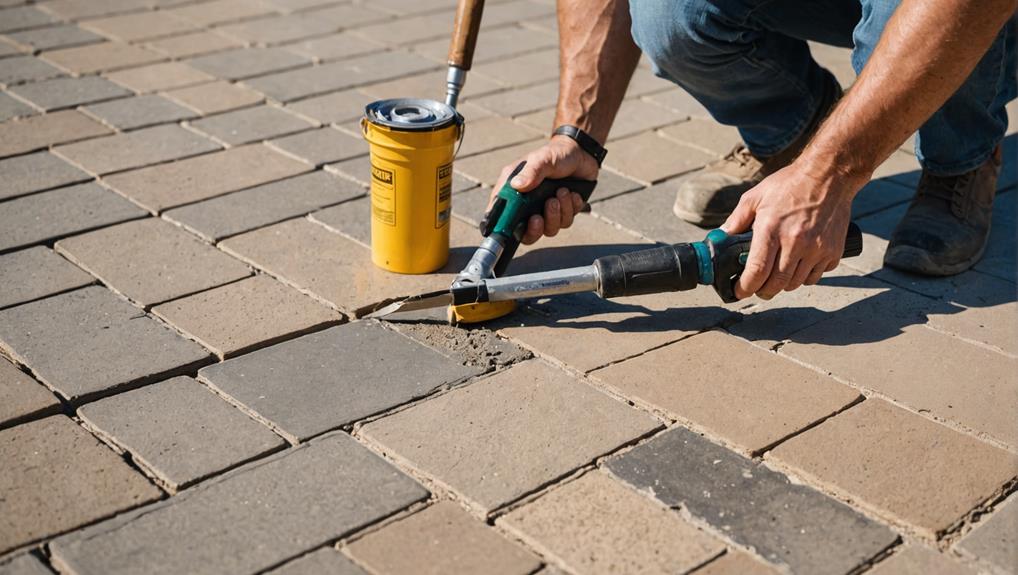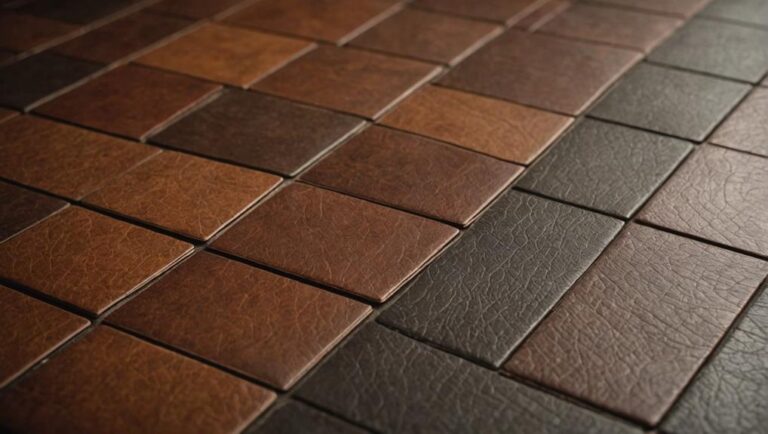To repair cracked pavers on your patio, start by evaluating the damage. Identify the type of cracks—hairline, wide, or displaced. Gather necessary tools like a chisel, hammer, and safety gear, then clean the cracked area thoroughly with a brush and appropriate solution. For filling the cracks, choose a compatible filler, like polymer-modified sand or epoxy, and apply it with a putty knife, ensuring a smooth finish. Once filled, seal the pavers to protect against moisture and stains. Following this, regular inspections and maintenance can prevent future issues, and you'll uncover essential tips for longevity and care.
Assessing the Damage
Before diving into repairs, it's vital to evaluate the damage to your pavers. This damage evaluation is significant for determining the appropriate repair method and ensuring your safety during the process. Start by examining the pavers closely; you'll want to identify the various crack types that may be present. Common types include hairline fractures, wide cracks, and those that have caused paver displacement.
For hairline cracks, these are usually superficial and may not require extensive repair. However, if left unattended, they can worsen over time. Wide cracks, on the other hand, indicate more significant issues, often related to base material settlement or moisture infiltration. These need immediate attention to prevent further damage. Displaced pavers may require re-leveling, as they can pose tripping hazards.
While evaluating, check for any signs of water pooling or erosion around the pavers. This could indicate underlying problems that might cause more extensive damage in the future. Document your findings by taking notes or photographs, which will help you formulate a clear repair strategy later.
Gathering Necessary Tools
Once you've assessed the damage to your pavers, the next step is to gather the necessary tools for the repair process. Having the right equipment on hand not only guarantees a smoother repair but also keeps you safe throughout the project. Here's a concise tools checklist to get you started:
- Safety Gear: Always prioritize safety. This includes gloves to protect your hands, safety goggles to shield your eyes from debris, and a dust mask if you'll be working with any materials that create dust.
- Chisel and Hammer: These are essential for removing any damaged pavers that need to be replaced. A chisel allows for precision, while a hammer provides the necessary force.
- Leveling Tool: To make certain your new or repaired pavers are perfectly aligned, a leveling tool will help you achieve a flat surface. This is significant for both aesthetic and functional purposes.
Once you've gathered this essential equipment, you'll be better prepared to tackle the cracks in your patio pavers. Make sure to double-check that you have everything before you start, as missing tools can lead to unnecessary delays. By being organized and equipped, you're setting the stage for a successful repair job. Remember, safety should always come first, so don't skip out on protective gear. With these tools in hand, you're ready to move on to the next steps in repairing your patio.
Cleaning the Cracked Area
Cleaning the cracked area is an essential step in guaranteeing a successful repair of your pavers. Before you begin, gather your cleaning supplies, which should include a stiff-bristle brush, a bucket, and appropriate cleaning solutions. Choose a cleaning solution that's safe for your type of pavers—often, a mixture of warm water and mild detergent is effective. If there are stubborn stains, you might need specialized stain removal products that are compatible with your paver material.
Start by removing any loose debris or dirt from the cracked area. Use the stiff-bristle brush to scrub the cracks gently, making sure you get into every crevice. For deeper stains, apply the cleaning solution directly and let it sit for a few minutes to penetrate the stain. Afterward, scrub the area again with your brush to lift the stain. Rinse the area thoroughly with clean water to make certain all cleaning solutions are washed away, as residues can interfere with the repair process.
If your pavers are particularly porous or have absorbed oils, consider using a degreaser specifically designed for paver cleaning. Always follow the manufacturer's instructions for any cleaning solution you use, and wear gloves and safety goggles to protect yourself during the cleaning process. Once you've cleaned the cracked area thoroughly and allowed it to dry completely, you're ready to proceed to the next step in your paver repair project.
Filling the Cracks
Now that you've cleaned the cracked area, it's time to focus on filling the cracks effectively. You'll need to select an appropriate filler that matches your pavers' material and color, ensuring a seamless repair. Once you've chosen the right product, you'll apply it carefully to restore the integrity and appearance of your pavers.
Selecting Appropriate Filler
Choosing the right filler is vital for effectively repairing cracked pavers. The type and color of filler you select can greatly influence both the durability of the repair and the overall appearance of your patio. Here are three key considerations to help you choose wisely:
- Filler Types: You'll find a variety of fillers available, including polymer-modified sand, epoxy, and concrete patching compounds. Each serves different purposes; for instance, polymer-modified sand is flexible and can accommodate minor movements, while epoxy provides a strong bond for larger cracks.
- Filler Colors: Matching the color of the filler to your existing pavers is essential for aesthetic appeal. Many fillers come in various shades, so you should choose one that closely resembles your paver color. This will help the repair blend seamlessly into the patio.
- Environmental Suitability: Consider the climate in your area. Some fillers are better suited for extreme temperatures or moisture levels, ensuring a long-lasting repair.
Cleaning the Cracks
When tackling the repair of cracked pavers, it is important to guarantee that the cracks are properly cleaned before applying any filler. Start by identifying the crack causes, such as weather conditions, shifting ground, or poor installation, as these can impact the effectiveness of your repair. Use a stiff-bristle brush to remove any loose debris, dirt, or algae from the cracks. This step guarantees that the filler will bond properly, preventing future issues.
Next, consider using a vacuum or compressed air to clear out any remaining particles. It is vital to eliminate all contaminants, as they can interfere with the adhesion of the filler. If the cracks are particularly deep or wide, you might also want to use a chisel or a small tool to widen the cracks slightly, allowing for better access and cleaning.
After thoroughly cleaning, rinse the area with water, and let it dry completely. This process not only enhances the appearance but also reduces the likelihood of needing repairs frequently. Taking these steps will set a solid foundation for an effective and long-lasting repair.
Applying the Filler
Applying the filler effectively is essential for guaranteeing a durable repair of cracked pavers. You'll want to choose the right filler type and application techniques to achieve the best results. Here's a quick guide to help you through the process:
- Select the Right Filler: Consider using polymeric sand, epoxy resin, or concrete patching compound. Each filler type offers unique benefits, so choose based on the crack size and environmental conditions.
- Prepare the Filler: Follow the manufacturer's instructions for mixing or preparing the filler. Confirm you're wearing safety gear, such as gloves and a mask, to protect yourself from dust and chemicals.
- Apply the Filler: Using a putty knife or trowel, carefully fill the cracks with your chosen material. Make sure to press it in firmly, eliminating air pockets, and smooth the surface to match the surrounding pavers. Allow adequate curing time as specified in the product guidelines.
Sealing the Pavers
Sealing the pavers is an essential step in maintaining their longevity and appearance, as it protects against moisture, stains, and fading. Choosing the right sealer type is vital; the two main categories are penetrating sealers and topical sealers. Penetrating sealers soak into the paver surface, providing a more natural look, while topical sealers form a protective layer on top, enhancing color and gloss. Depending on your patio's material, one type may be more suitable than the other.
Before you apply the sealer, verify the pavers are clean and dry. Use a pressure washer or a stiff-bristled broom to remove dirt and debris, allowing at least 24 hours for the surface to dry completely. When you're ready to seal, choose a day with mild weather to facilitate proper curing.
For application techniques, consider using a roller or a sprayer for an even coat. If you opt for a sprayer, maintain a steady distance to avoid pooling. Work in small sections and overlap your strokes to guarantee complete coverage. Typically, you'll want to apply at least two coats for maximum protection, allowing the first coat to dry before applying the second.
Remember to wear protective gear, such as gloves and a mask, especially if you're working with solvent-based sealers. Finally, allow the sealed pavers to cure for the recommended time before walking on them, usually 24 to 48 hours, to guarantee the best results.
Maintaining Your Patio
To keep your patio in top shape, you'll need to implement regular cleaning practices and conduct seasonal inspections. These steps help you identify any potential issues before they escalate, ensuring longevity and aesthetics. Additionally, adopting preventative maintenance tips can save you time and money on repairs down the line.
Regular Cleaning Practices
Maintaining your patio involves consistent cleaning practices that can greatly prolong the life of your pavers. Regular cleaning not only enhances patio aesthetics but also prevents the buildup of harmful substances that can lead to cracks and other damage. Here's how to approach it effectively:
- Sweep Weekly: Remove debris like leaves, dirt, and sand weekly. This prevents stains and keeps your pavers looking fresh.
- Pressure Wash Monthly: Use a pressure washer on a low setting to eliminate stubborn dirt and algae. Make sure you're at least 12 inches away to avoid damaging the surface.
- Seal Annually: After thorough cleaning, apply a sealant to protect your pavers from moisture and stains. This can greatly enhance durability and maintain the vibrant look of your patio.
Seasonal Inspections Importance
Regular seasonal inspections are essential for the longevity of your pavers and the overall health of your patio. These inspections allow you to assess the structural integrity of your pavers, ensuring they remain safe and functional. Seasonal weather impacts, such as freeze-thaw cycles or heavy rainfall, can lead to shifts in the ground beneath your pavers, causing cracks or misalignment.
During your inspection, look for signs of wear, such as loose or uneven stones, and check for any visible cracks that may have developed. It's vital to address these issues early to prevent further damage and potential safety hazards. Pay attention to the joints between the pavers as well; damaged or eroded joints can allow water to seep underneath, leading to instability.
Additionally, evaluate the drainage system around your patio. Proper drainage prevents water accumulation, which can exacerbate structural issues. A thorough structural integrity assessment during each season will help you identify and rectify problems before they escalate, ensuring a safe and enjoyable outdoor space. By committing to regular inspections, you're not only prolonging the life of your patio but also protecting your investment.
Preventative Maintenance Tips
Consistently performing preventative maintenance on your patio can greatly extend the life of your pavers and enhance their appearance. By focusing on paver durability and improving weather resistance, you can prevent costly repairs down the line. Here are three practical tips to keep your patio in top shape:
- Regular Cleaning: Sweep your patio regularly to remove debris and dirt. Use a pressure washer occasionally to eliminate stubborn stains. This can prevent mold and mildew, which can weaken paver integrity.
- Sealing: Apply a high-quality sealant every couple of years. This not only boosts paver durability but also enhances weather resistance against rain, snow, and UV rays. Make sure to choose a sealant compatible with your type of pavers.
- Joint Maintenance: Inspect the joints between pavers regularly. Refill any gaps with sand or polymeric jointing material to prevent weed growth and erosion. This keeps your patio stable and reduces the displacement of pavers.
Frequently Asked Questions
Can I Repair Cracked Pavers During Winter Months?
Yes, you can repair cracked pavers during winter months, but it's crucial to take into account the paver materials and weather conditions. Cold temperatures can affect the curing process of repair materials, leading to potential safety hazards. For winter maintenance, use products specifically designed for low temperatures. Verify the area is free of ice and snow before starting. Always prioritize safety by wearing proper gear and allowing adequate curing time to achieve a durable repair.
How Often Should I Inspect My Patio for Cracks?
Did you know that nearly 30% of homeowners overlook regular patio maintenance? To guarantee safety, you should inspect your patio for cracks at least twice a year, ideally in spring and fall. Regular crack detection helps you identify issues before they worsen, preventing potential hazards. Keep an eye out for shifting or uneven surfaces, as these can indicate underlying problems. Addressing cracks promptly can save you time and money in the long run.
What Types of Pavers Are Easiest to Repair?
When considering paver materials, concrete and brick pavers are among the easiest to repair. Their uniform size allows for straightforward removal and replacement if cracks occur. For effective repair techniques, you can use polymeric sand to fill gaps or sealant for minor surface cracks. It's essential to guarantee a stable base during repairs to prevent future damage. Regular maintenance will keep your patio safe and extend the lifespan of your pavers.
Are There Any DIY Alternatives to Professional Repair?
If you're considering DIY alternatives to professional repair, there are practical solutions available. For minor cracks, DIY patching using a polymer-modified mortar can effectively fill gaps. Alternatively, epoxy solutions are excellent for more significant damage, providing a strong bond and durability. Make certain you clean the area thoroughly before applying any materials. Always wear safety gloves and goggles to protect yourself during the process, guaranteeing a safe and effective repair.
How Can I Prevent Future Cracks in My Pavers?
Think of your pavers as a protective armor for your outdoor space; keeping them strong requires vigilance. To prevent future cracks, focus on paver maintenance tips like regular cleaning and joint replenishment. Consider sealing options that provide a barrier against moisture and weeds, enhancing durability. Also, guarantee proper drainage to avoid water pooling, which can erode the base. With these strategies, you'll safeguard your pavers and maintain their beauty for years to come.




